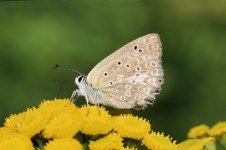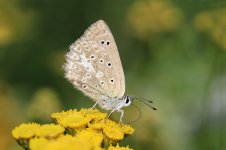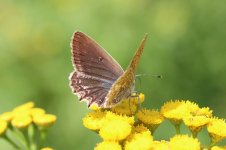
Amazing day on Saturday! Whilst searching for Chalkhill Blues in southern Lithuania, I discovered a female Meleager's Blue (Meleageria daphnis) taking nectar from Tansy (Tanacetum vulgare) flowers ...not only the first record of this species in Lithuania, but first for the Baltic States. The site, located less than a hundred metres from the Belarus border, was an area of mixed meadows and pine forest, largely on sandy soils. Active and mobile, the butterfly was watched for about fifteen minutes as it moved rapidly from flower clump to flower clump, the habitat being an abandoned meadow rich in flowers and over growing with raspberries, assorted shrubs, bushes and occasional pines in places.
Luckier still, this was a female - sexually dimorphic, the female is the more distinctive of the species, the pronounced scalloping to the rear hindwings making it unique amongst European Lycaenidae.
With a European distribution range stretching from southern Europe through to Ukraine and the Balkans, the closest known populations of Meleager's Blue are in southern Poland and northern Ukraine, approximately 380-400 km south of the Lithuanian border. As a non-migratory species, its occurrence in Lithuania is quite remarkable, opening the possibility that unknown populations exist between this locality and the known range, i.e. in areas of Belarus or Poland. As the food plants of the caterpillar, Crown Vetch (Coronilla varia) and Wild Thyme (Thymus serpyllum), occur in southern Lithuania, potential exists that further records may occur, though the complicated life cycle of the species also requires the presence of ant species (genera Lasius, Formica or Tapinoma) to tend the larvae.
As a side note, simultaneous with the discovery of this Meleager's Blue in Lithuania, another butterfly of largely southern distribution, namely Marbled White (Melanargia galathea) was present in exceptional numbers in the same general area. Prior to 2016, the only records of this species in Lithuania were in 1921 and 1926 (three individuals in Panevezys) and 2001 (one individual in Viesville). In 2016, representing an unprecedented influx into the border area, I found an absolute minimum of 58 individuals between 23-30 July at three sites in close proximity, with a further single at a site 30 km further north-east. Students have also found further individuals at a distance of approximately 10 km from this last site.
With the acceptance of Meleager's Blue, I believe the Lithuanian butterfly list stands at 126 species. Eight further species are noted in 'Butterflies of Lithuania' (Povilas Ivinskis & Jonas Augustauskas, 2004) as possible contenders to be recorded in the future, though Meleager's Blue was not among these.
Luckier still, this was a female - sexually dimorphic, the female is the more distinctive of the species, the pronounced scalloping to the rear hindwings making it unique amongst European Lycaenidae.
With a European distribution range stretching from southern Europe through to Ukraine and the Balkans, the closest known populations of Meleager's Blue are in southern Poland and northern Ukraine, approximately 380-400 km south of the Lithuanian border. As a non-migratory species, its occurrence in Lithuania is quite remarkable, opening the possibility that unknown populations exist between this locality and the known range, i.e. in areas of Belarus or Poland. As the food plants of the caterpillar, Crown Vetch (Coronilla varia) and Wild Thyme (Thymus serpyllum), occur in southern Lithuania, potential exists that further records may occur, though the complicated life cycle of the species also requires the presence of ant species (genera Lasius, Formica or Tapinoma) to tend the larvae.
As a side note, simultaneous with the discovery of this Meleager's Blue in Lithuania, another butterfly of largely southern distribution, namely Marbled White (Melanargia galathea) was present in exceptional numbers in the same general area. Prior to 2016, the only records of this species in Lithuania were in 1921 and 1926 (three individuals in Panevezys) and 2001 (one individual in Viesville). In 2016, representing an unprecedented influx into the border area, I found an absolute minimum of 58 individuals between 23-30 July at three sites in close proximity, with a further single at a site 30 km further north-east. Students have also found further individuals at a distance of approximately 10 km from this last site.
With the acceptance of Meleager's Blue, I believe the Lithuanian butterfly list stands at 126 species. Eight further species are noted in 'Butterflies of Lithuania' (Povilas Ivinskis & Jonas Augustauskas, 2004) as possible contenders to be recorded in the future, though Meleager's Blue was not among these.
Last edited:








